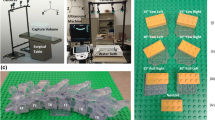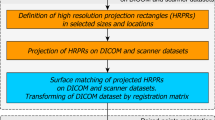Abstract
Registration is a critical and important process in maintaining the accuracy of CT-based image-guided surgery. The aim of this study was to evaluate the effects of the area of intraoperative data sampling and number of sampling points on the accuracy of surface-based registration in a CT-based spinal-navigation system, using an optical three-dimensional localizer. A cadaveric dry-bone phantom of the lumbar spine was used. To evaluate registration accuracy, three alumina ceramic balls were attached to the anterior and lateral aspects of the vertebral body. CT images of the phantom were obtained (1-mm slice thickness, at1-mm intervals) using a helical CT scanner. Twenty surface points were digitized from five zones defined on the basis of anatomical classification on the posterior aspects of the target vertebra. A total of 20 sets of sampling data were obtained. Evaluation of registration accuracy accounted for positional and rotational errors. Of the five zones, the area that was the largest and easiest to expose surgically and to digitize surface points was the lamina. The lamina was defined as standard zone. On this zone, the effect of the number of sampling points on the positional and rotational accuracy of registration was evaluated. And the effects of the additional area selected for intraoperative data sampling on the registration accuracy were evaluated. Using 20 surface points on the posterior side of the lamina, positional error was 0.96 mm±0.24 mm root-mean-square (RMS) and rotational error was 0.91°±0.38°RMS. The use of 20 surface points on the lamina usually allows surgeons to carry out sufficiently accurate registration to conduct computer-aided spine surgery. In the case of severe spondylosis, however, it might be difficult to digitize the surface points from the lamina, due to a hypertrophic facet joint or the deformity of the lamina and noisy sampling data. In such cases, registration accuracy can be improved by combining use of the 20 surface points on the lamina with surface points on other zones, such as on the both sides of the spinous process.




Similar content being viewed by others
References
Amiot LP, Labelle H, DeGuise JA, Sati M, Brodeur P, Rivard CH (1995) Computer-assisted pedicle screw fixation. A feasibility study. Spine 20:1208–1212
Amiot LP, Lang K, Putzier M, Zippel H, Labelle H (2000) Comparative results between conventional and computer-assisted pedicle screw installation in the thoracic, lumbar, and sacral spine. Spine 25:606–614
Besl PJ, McKay ND (1992) A method for registration of 3D shapes. IEEE Transactions on Pattern Analysis and Machine Intelligence, vol 14, No. 2. pp 239–256
Carl AL, Khanuja HS, Sachs BL, Gatto CA, vomLehn J, Vosburgh K, Schenck J, Lorensen W, Rohling K, Disler D (1997) In vitro simulation. Early results of stereotaxy for pedicle screw placement. Spine 22:1160–1164
Foley KT, Smith MM (1996) Image-guided spine surgery. Neurosurg Clin N Am 7:171–186
Foley KT, Simon DA, Rampersaud YR (2001) Virtual fluoroscopy: Computer-assisted fluoroscopic navigation. Spine 26:347–351
Girardi FP, Cammisa FP, Sandhu HS, Alvarez L (1999) The placement of lumbar pedicle screws using computerised stereotactic guidance. J Bone Joint Surg Br 81:825–829
Herring JL, Dawant BM, Maurer CR, Muratore DM, Galloway RL, Fitzpatrick JM (1998) Surface-based registration of CT images to physical space for image-guided surgery of the spine: a sensitivity study. IEEE Trans Med Imaging 17(5):743–752
Kalfas IH, Kormos DW, Murphy MA, McKenzie RL, Barnett GH, Bell GR, Steiner CP, Trimble MB, Weisenberger JP (1995) Application of frameless stereotaxy to pedicle screw fixation of the spine. J Neurosurg 83:641–647
Laine T, Schlenzka D, Makitalo K, Tallroth K, Nolte LP, Visarius H (1997) Improved accuracy of pedicle screw insertion with computer-assisted surgery. A prospective clinical trial of 30 patients. Spine 22:1254–1258
Laine T, Lund T, Ylikoski M, Lohikoski J, Schlenzka D (2000) Accuracy of pedicle screw insertion with and without computer assistance: a randomised controlled clinical study in 100 consecutive patients. Eur Spine J 9:235–240
Lavallee S, Sautot P, Troccaz J, Cinquin P, Merloz P (1995) Computer-assisted spine surgery: a technique for accurate transpedicular screw fixation using CT data and a 3D optical localizer. J Image Guid Surg 1:65–73
Lorensen W, Cline H (1987) Marching cubes: A high resolution 3D surface reconstruction algorithm. In: Computer graphics. SIGGRAPH 1987 Proceedings, pp 163–169
Merloz P, Tonetti J, Eid A, Faure C, Lavallee S, Troccaz J, Sautot P, Hamadeh A, Cinquin P (1997) Computer assisted spine surgery. Clin Orthop 337:86–96
Merloz P, Tonetti J, Pittet L, Coulomb M, Lavallee S, Sautot P (1998) Pedicle screw placement using image guided techniques. Clin Orthop 354:39–48
Merloz P, Tonetti J, Pittet L, Coulomb M, Lavallee S, Troccaz J, Cinquin P, Sautot P (1998) Computer-assisted spine surgery. Comput Aided Surg 3:297–305
Nolte LP, Zamorano LJ, Jiang Z (1995) Image-guided insertion of transpedicular screws. A laboratory set-up. Spine 20:497–500
Nolte LP, Visarius H, Arm E, Langlotz F, Schwarzenbach O, Zamorano L (1995) Computer-aided fixation of spinal implants. J Image Guid Surg 1:88–93
Nolte LP, Zamorano L, Visarius H, Berlemann U, Langlotz F, Arm E, Schwarzenbach O (1995) Clinical evaluation of a system for precision enhancement in spine surgery. Clin Biomech (Bristol, Avon) 10:293–303
Nolte L, Zamorano L, Arm E, Visarius H, Jiang Z, Berlerman U, Schwarzenbach O (1996) Image-guided computer-assisted spine surgery: a pilot study on pedicle screw fixation. Stereotact Funct Neurosurg 66:108–117
Nolte LP, Slomczykowski MA, Berlemann U et al. (2000) A new approach to computer-aided spine surgery: fluoroscopy-based surgical navigation. Eur Spine J 9 [Suppl 1]:S78–88
Weinstein JN, Spratt KF, Spengler D, Brick C, Reid S (1988) Spinal pedicle fixation: reliability and validity of roentgenogram-based assessment and surgical factors on successful screw placement. Spine 13:1012—1018
Acknowledgement
This study was supported under the project entitled “Development of a Surgical Robot,” sponsored by the Research for the Future Program of the Japan Society for the Promotion of Science
Author information
Authors and Affiliations
Corresponding author
Additional information
Part of this study was presented at the CAOS USA 2000 meeting in Pittsburgh
Rights and permissions
About this article
Cite this article
Tamura, Y., Sugano, N., Sasama, T. et al. Surface-based registration accuracy of CT-based image-guided spine surgery. Eur Spine J 14, 291–297 (2005). https://doi.org/10.1007/s00586-004-0797-y
Received:
Revised:
Accepted:
Published:
Issue Date:
DOI: https://doi.org/10.1007/s00586-004-0797-y




